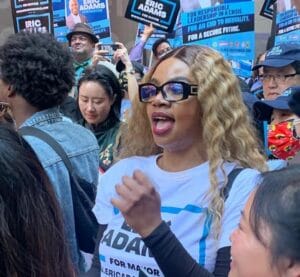Press Briefing by White House COVID-19 Response Team and Public Health Officials

Via Teleconference
11:48 A.M. EST
ACTING ADMINISTRATOR SLAVITT: Good morning. Thank you for joining our COVID-19 Response briefing. First, I want to start by saying that our hearts go out to the people in Texas, Louisiana, and across the country who have been impacted by the severe weather this week.
Now, I want to give an update on how severe weather across the country has impacted vaccine deliveries and administration, and how we intend to catch up. As of now, we have a backlog of about 6 million doses due to the weather. All 50 states have been impacted. The 6 million doses represents about three days of delayed shipping, and many states have been able to cover some of this delay with existing inventory.
So let me first walk you through the situation and then tell you how we, as an entire nation, will have to pull together to get back on track. There are three places along the distribution chain that have been impacted by the weather. First, FedEx, UPS, and McKesson — our logistics and distribution teams — have all faced challenges as workers have been snowed in and unable to get to work to package and ship the vaccines, kits, and the required diluent.
Second, road closures have held up delivery of vaccines at different points in the distribution process, between manufacturing sites to distribution, and to shipping hubs.
Third, more than 2,000 vaccine sites are located in areas with power outages, so they’re currently unable to receive doses. General Perna’s guidance to the team was to ensure safety of personnel, preservation of the vaccines and supplies, and constant communication with the states. Because of 72-hour cold chain constraints, we don’t want to ship doses to those locations and have them sitting at a site where they might expire. So the vaccines are sitting safe and sound in our factories and hubs, ready to be shipped out as soon as the weather allows.
Now, as weather conditions improve, we’re already working to clear this backlog. 1.4 million doses are already in transit today, and we anticipate that all the backlog doses will be delivered within the next week, with most being delivered within the next several days. And we expect we will be able to manage both this backlog and the new production coming online next week.
With everybody’s hard work and collective effort, we will be able to catch up, but we understand this will mean asking more of people. UPS and FedEx both will support Saturday deliveries tomorrow. We are working with the jurisdictions to see which ones are able to take Saturday deliveries. The packaging plant for Moderna vaccines is just now coming online. Roads are being cleared for the workforce to leave their homes. They’re working today through Sunday to package the backlogged orders, and will put the vaccines and ancillary supplies on aircraft on Sunday night for Monday-through-Wednesday delivery.
As we get back on track, we’re asking states, sites, and ventilate — and vaccinators to help us catch up and to get Americans vaccinated. We know many Americans are awaiting their second dose, and many more, their first dose. We’re asking vaccine administration sites to extend their hours even further and offer additional appointments, and to try to reschedule the vaccinations over the coming days and weeks as significantly more supply arrives. States and vaccination sites are going to want to be prepared for the additional volume.
Whatever reduction we see in our seven-day average this week in vaccinations from the weather, if we all work together — from the factory, all the way to the vaccinators — we will make up for it in the coming week.
I want to personally thank the men and women who have continued to keep our operations up and running throughout this storm and have been working 24 by 7 with the states, and with local vaccination sites. And my thoughts remain with all of those impacted.
I’ll be happy to answer any questions about this topic. But before we turn it over to Dr. Walensky and Dr. Fauci, I do want to briefly touch on our work to stand up more federally run sites. Even as we manage the weather, on the one hand, we are pushing ahead with plans to get more vaccines to more places to get more Americans vaccinated.
Today, I’m pleased to announce we’ll be opening five additional vaccination centers: one in Pennsylvania and four in Florida. In Florida, we will stand up four major new community vaccination centers, in partnerships with the state, in Orlando, Miami, Jacksonville, and Tampa. These sites will have the capacity to vaccinate a total of 12,000 individuals per day in total.
In Pennsylvania, we’re announcing a major new community vaccination center at the Pennsylvania Convention Center in Philadelphia. This site will have the capacity to deliver 6,000 doses per day.
Selection of all of these sites is based on a CDC-FEMA framework that has been developed to target vaccinations to those who are most vulnerable. The goal is to launch vaccination sites that use processes and are in locations that promote equity and deploy the CDC’s Social Vulnerability Index.
The federal government will be deploying teams immediately to work hand in hand with state and local jurisdictions to get these sites set up, and we expect both — we expect them all to be up and running in the next two weeks.
So that’s a brief status from the White House COVID Response Team here. We’ll have more announcements to come next week.
Now, with that, I will turn it over to Dr. Walensky to overview a state of the pandemic and public health.
Dr. Walensky.
DR. WALENSKY: Thank you so much. I’m delighted to be back with you today.
I have new information to share from CDC regarding ongoing safety monitoring of the COVID-19 vaccines. But before I go into those findings, I want to provide a brief overview of the latest data on the pandemic.
We continue to see a five-week decline in COVID cases, with cases decreasing 69 percent in the seven-day average since hitting a peak on January 11th. The current seven-day average of approximately 77,000 cases is the lowest recorded since the end of October but still higher than the height of last summer’s peak.
Like new COVID-19 cases, the number of new hospital admissions continues to drop. The seven-day average of new admissions on February 16th, approximately 7,200, represents a 56 percent decline since the January 9th peak.
As I reported on Wednesday, the number of deaths continues to fluctuate. The latest data indicate that deaths have declined modestly in the past week to an average of approximately 2,700 per day. These numbers are a stark reminder of the thousands of lives lost to this pandemic.
Another reminder of the devastating impact of the pandemic has had on our country was brought into clear view yesterday in a report released by the CDC on the provisional life expectancy in the first half of 2020. The report found that life expectancy was at its lowest level in 15 years, dropping by a full year compared to the life expectancy in 2019. This represents a substantial decline in life expectancy in our nation.
Importantly, like the populations most heavily affected by this pandemic, the declines in life expectancy were again most pronounced in certain racial and ethnic minority groups. The largest declines in life expectancy occurred in non-Hispanic black persons, dropping 2.7 years — levels not seen since 2001. And Hispanic persons had lost the second largest life expectancy, dropping 1.9 years.
These findings, though not surprising, are sobering and representative of the continued need to take this pandemic, and actions to stop the spread of COVID-19, seriously.
Now more than ever, with continued spread of variants that stand to threaten the progress we are making, we must recommit to doing our part to protect one another: wear a well-fitting mask, social distant, avoid travel and crowds, practice good hand hygiene, and get vaccinated when the vaccine is available to you.
I also want to spend a moment talking about vaccine safety. To date, more than 41 million people in the United States have received at least one dose of the COVID-19 vaccine, but we continue to hear that people might be reluctant to roll up their sleeve because they are worried about adverse effects.
I will reiterate: The CDC is committed to monitoring vaccine safety and frequently reporting on what we know. Today, CDC is releasing a study in the Morbidity and Mortality Weekly Report that describes findings from our COVID-19 vaccine safety monitoring in the United States from December 14th through January 13th, 2021.
During the first month of vaccinations, approximately 1.6 million people enrolled in V-safe, CDC’s new phone-based COVID-19 vaccine safety monitoring system. Among those enrolled, 71 percent reported pain where the shot was given, 34 percent reported fatigue, and 30 percent reported a headache. These are common with most vaccines, and they typically resolve within a day or two of vaccination.
It’s important to know that about half the people don’t feel very well after getting their second dose. This should not deter you from getting your second dose, but you need to have a light day of activity after getting vaccinated.
There were also rare reports of severe allergic reactions like anaphylaxis, a serious but treatable reaction. In fact, there were 4.5 cases of anaphylaxis per 1 million doses given during this time — a rate similar to what we’ve seen in other commonly used vaccines.
In the first month of experience, a total of 113 deaths were reported of which approximately 65 percent were among long-term care facility residents. A thorough review of the available data indicated that these deaths were not related to the COVID-19 vaccine. And the death rate in this population, though truly sad and unfortunate, was consistent with the expected background death rate in this demographic.
I want to emphasize that we’ve implemented the most comprehensive vaccine safety monitoring system program in our history, and the data released from the CDC today are reflective of this effort. We will continue to closely monitor these events and report back as further data emerge.
I want to be sure that you know the facts and not the myths about the vaccine safety — about vaccine safety. The fact is they are safe and they will save lives. And that is why we are committed to working with state and local public health partners, as well as partners in the private sector, to support getting people vaccinated and quickly and as safely as possible.
To help advance our collective efforts to scale up vaccines in communities, on Monday, CDC is convening a three-day virtual National Forum on COVID-19 Vaccine. The forum will bring together a broad range of governmental and non-governmental partners to share information and best practices on how to build trust and confidence in COVID-19 vaccines; how to use data to optimize vaccine implementation; and how to provide practical, real-world experience on how to increase vaccination capacity in communities, especially for those at increased risk of COVID-19 and for those who may face barriers to vaccination.
I’m excited about this forum and the rich dialogue it will stimulate. And I invite those who are involved in vaccine efforts to register and attend this important meeting. Thank you. As always, I look forward to your questions. But before that, I’ll turn it over to Dr. Fauci.
Dr. Fauci.
DR. FAUCI: Thank you very much, Dr. Walensky. What I’d like to do is to just take a couple of minutes, very briefly, reviewing the status of the vaccines and vaccine trials that we have, but then to, as I’ve done in the past, pick out a question that I believe is being asked more frequently to try and preemptively address it and perhaps generate some discussion.
With regard to the trials that we have: As you know, the U.S. government had been involved in the development of and/or facilitation of the testing of three separate platforms represented by six different companies. You’re all aware of the data of the Moderna and the Pfizer-BioNTech, which have their EUA now, having shown a 94 to 95 percent efficacy.
Right now, as we speak, the data from the Johnson study — which, as you know, showed a 72 percent efficacy in the United States, but was also done in South Africa and Latin America and showed a diminished efficacy against the variant, but very good against severe disease — that is being reviewed at the FDA for the U.S. data. And on February the 26th, the FDA will consult with their independent Advisory Committee, their VRBPAC, and we should be hearing from them soon.
With regard to the AstraZeneca and the Novavax, those trials are both fully enrolled. These are event-driven decisions, so when they reach a certain amount of events, they will then look at the data and make decisions as to whether or not to go ahead with a request for an EUA.
So, having said that, let me just now, very briefly, address a question that is a very relevant question that we are now more commonly being asked: If you look at the existing trials — those that have already gotten an EUA, and those that we anticipate and hope will get and EUA — when will we be able to say we can vaccinate children — children in the high school range and children in the elementary school range?
You know from Pfizer that they started off with the trial of 44,000 individuals, down to 16-year-olds and then progressed it down to 12-year-olds. So what they’re going to be doing in April — starting in April, they are going to be studying 12-year-olds down to five- to six-year-old. That will take likely one year to get the information on that — likely not until the first quarter.
However, we anticipate data on high-school-age individuals, namely individuals 12 years old to 17 years old, by the beginning of the fall. Maybe not exactly coinciding with the first day of school, but sometime in the fall, we will have that. Moderna, as you know, started off with already 18-year-old. They are now currently enrolling 12- to 17-year-olds.
So let me take a moment to explain the process of how you get relevant information regarding these younger individuals. This is a representative trial, which very likely will reflect other trials. It’s a 3,000-person trial. So, right off, you’re not dealing with the 30,000- and 44,000-person trial that gave the efficacy signal in the original Moderna and Pfizer study.
What the trial is, is the trial is what’s called a “non-inferiority by immunogenicity,” which is a lot of big words to really mean what they’re asking: Is it safe in the children, and does it induce an immune response that’s comparable or not inferior to the immune response that we know is associated with efficacy in the other trials? And that’s the way that trial will go.
And then, we’re starting, by the end of March, they will do what’s called an “age de-escalation study.” We’re already enrolling on the 12 to 17. They will go to the 6 to 12, then 2 to 6, then 6 months to 2 years. Again, we will likely get information for high schoolers at some time in the fall, but it is, I would say, more than unlikely we will not have data on elementary school children until at least the first quarter of 2022.
Similar types of approaches are being taken by the other candidates, the other companies, namely J&J, Novavax, and AZ.
So, the bottom line of all of this is as follows: It is highly likely that sometime in the fall, we will have data that will give us the capability of saying the safety and comparable efficacy in children 12 to 17, 18 years old. Again, the final decisions we always leave to the FDA. I’m trying to give you a roadmap of what likely will happen. But then also, with the studies that I just mentioned, to getting the information to make the decision in elementary school children almost certainly will not be firmed down until the first quarter of 2022.
I will stop there and hand it back to Andy.
ACTING ADMINISTRATOR SLAVITT: Thank you, Dr. Fauci.
Okay, we can take some questions.
MODERATOR: All right. First up, we will have Jonathan Cohn, Huffington Post.
Q Thanks for taking the question. I have a question about the federal mass vaccination sites and how you’re deciding where to do them and setting them up. How much of this is states coming to you and saying, “Okay, you know, we need help with this place or that place. Can you come in and set up a FEMA site?” How much is this you going to the states and saying, “Hey, it looks like you need some help here, or we see that, you know, the progress — you know, you’re not hitting enough of the underserved communities, so we think you — we want to do a site here”?
And, in general, has there been a, kind of, overall 50-state assessment of how the states are doing at distribution and where they need help? Have you done something like that — some kind of comprehensive look?
ACTING ADMINISTRATOR SLAVITT: Yeah, thanks, Jonathan. And I may ask Dr. Walensky to come in, in a second, on how the CDC thinks about the Social Vulnerability Index in places where we’d like to target.
What I would reflect for you, Jonathan, is we have a very healthy ongoing dialogue with multiple participants in a state every week, and there is a good give and take.
We are obviously looking for two things as we select these sites. The first is, how can we get more people vaccinated more quickly. And the second is, how can we get more people vaccinated more equitably. Those are the — those are really the two most important criteria. And so having these conversations, these dialogues go back and forth, we — you know, to — you know, as an illustration, we may have a governor who says, “We’re very interested in this.” And then, when we work with the CDC and with FEMA, we may say, “If we do something in this state, this is the location that we think works best and makes sense.” And then we’ll have a back and forth. So, it’s very collaborative. It’s very positive.
Dr. Walensky, anything you want to add more specifically?
DR. WALENSKY: I don’t have a whole lot to add to that, except to say that, really, it is a collaborative. We are doing outreach and we are actually receiving — we’re trying to incorporate what states’ specific needs are. We do look specifically at the Social Vulnerability Index of where these sites might go, also the population size so we can understand exactly what the needs are in those specific sites.
So, it’s a deep collaboration, and it looks both at Social Vulnerability Index, the outreach that’s needed, whether there’s, you know, the size, as well as what mobile units might be needed as well.
ACTING ADMINISTRATION SLAVITT: Yeah, Jonathan, federal-state partnership to us is the key and is the approach. And we view ourselves, hopefully, as good partners to the states. And if they — if they bring us challenges, our goal is to help them solve them, not to reward or punish, as I think has been a prior philosophy.
Let’s go to the next question.
MODERATOR: Next, we’ll go to Cheyenne Haslett at ABC News.
Q Hi, thanks for doing this. Thanks. On school openings, my question is about 75 percent of schools that are currently located in the red zones, which the CDC guidelines recommend be hybrid or virtual. So, I’m wondering how, in April, just about two months from now, the President intends to make good on that promise of full-time in-person schooling.
ACTING ADMINISTRATOR SLAVITT: Well, thanks for that question. And I think that that question actually allows us to clarify a few things, and I want to turn to Dr. Walensky to do that.
DR. WALENSKY: Yeah, thank you for that question. The first thing I just want to convey is there are opportunities for in-person learning at all stages — all states of community spread.
As we’ve seen community spread coming down and as we’ve seen our numbers improving right now, what I would invite the schools to do — we have actually seen many more communities leave the red zone and move into the orange zone, which actually has more opportunities for in-school opening and for in-person learning. So, our numbers are coming down, and I would actually invite schools to lean in and to look at what is needed so that — in the roadmap, to try and get more and more children back to school.
ACTING ADMINISTRATOR SLAVITT: And I want to just clarify something you said because it’s so important, Dr. Walensky. Is it possible, if you are in the red zone, even if things are improving, is it possible to open schools under the CDC’s guidance?
DR. WALENSKY: Absolutely. So, in the areas that remain red — and there are about two thirds of districts now, although the numbers continue to climb — in the numbers that remain red, we say, with universal masking and physical distancing and de-densification of classrooms, there are opportunities for in-person learning, as well as for middle and high school learning, and assuming you’re able to do the de-densification that we suggest.
ACTING ADMINISTRATOR SLAVITT: Great. And I think that’s a really important clarification.
Next question, please.
MODERATOR: Next, we’ll go to Brenda Goodman at WebMD.
Q Hi. I have a question about dosing. There have been several studies published in the last couple of days — the dosing of the vaccines, that is — that have suggested that just a single dose of the vaccine might be highly effective after about three — two or three weeks. And I wondered if that had shifted, Dr. Fauci — if it had convinced you that just a single dose of the mRNA vaccines might end up being effective.
DR. FAUCI: Well, if you’re referring to the mRNA vaccine, you’re probably referring to a recent Israeli study that looked at the mRNA, because the extension of the time in a single dose with AZ has also been discussed. But let me refer and just answer directly your question with the mRNA.
We always look at data very carefully and very seriously, and we evaluate it as it evolves. But if you look at the data from the particular study, and then go back and look at why we wound up with a prime and a boost — and for Moderna, as you know, that’s 28 days, and for Pfizer, it’s 21 days. And the reason is, even though you can get a fair degree of, quote, “protection” after a single dose, it clearly is not durable. We know that. The durability is not as much as the durability that you would get with the boost.
Secondly, if you look at the difference between the degree — the intensity of the response after a first dose and compare it to that of the second dose, the second dose is 10 times higher in the sense of level of neutralizing antibodies, which is one of the parameters of immunity.
So, again, although the numbers of a single dose do look interesting, the one thing we don’t know is how durable it is. And since it’s 10 times less than the optimal dose that you would get, you have to look at it from two standpoints. You remember we discussed, on one of these press briefings before, that the reason why you look clinically and see that, despite the fact that there is a maybe five- to six-fold diminution in the impact of the antibodies that are induced by the mRNA candidates, it still is within the range of protection.
The reason for that is that the response following the boost was so high that even though you diminished the efficacy down to about 50 percent, you still had rather good efficacy against severe disease. So it’s a variant issue to protect against variant.
The other issue that we need to take into consideration is if you do have a less than optimal — even though with numbers they look reasonably good — but not as good as the optimal response, what could happen theoretically is that because of the immunological pressure that you see on the virus, you might actually, theoretically, be inducing more variants. So there are a few scientific reasons why we feel, given the information we have right now, we will stick with the scientifically documented efficacy and optimal response of a prime, followed by a boost, with the mRNA.
ACTING ADMINISTRATOR SLAVITT: Dr. Fauci, just a couple of additional clarifications. You said something here which is important for, I think, the public to understand. If we do see more of the variant present in this country, do you feel better with people having two doses of these mRNA vaccine or one?
DR. FAUCI: Oh, there’s no doubt, Andy. Thank you for the question. I alluded to it, but thank you for giving me the opportunity to repeat it. There’s no doubt about that, that you have an optimal response. When you’re dealing with variants, you want enough of a height of a response that even if you diminish it, you don’t diminish it so much to get out of the realm of protection, number one.
Number two, if you do have a less-than-optimum response, you could theoretically and inadvertently be selecting immunologically for variants.
ACTING ADMINISTRATOR SLAVITT: Thank you. So just a couple of things to emphasize here. One is, we want the public not to be confused: The recommendation from the FDA is two doses, just as it always has been.
Number two — and I think this is a, sort of, more macro point, and I invite either Dr. Fauci or Dr. Walensky to comment here — there are studies all the time. There are preprints all the time. There are — real-world evidence comes out all the time. And it will continue to happen.
The people at the FDA, led by Peter Marks, people like Dr. Fauci, people like Dr. Walensky, love looking at this data, love looking at these studies. But it’s also important to understand that — that one study, even though it may look attractive, if it’s in the public domain and may capture a headline, isn’t always what it appears to be and it is only one study. So I think we’ve got the best people in the world looking at this. I feel very confident. And they’ll look aggressively at these studies. But I think it’s important that people understand that we’re not going to be persuaded by one study that happens to grab headlines. We, here at the White House, will, of course, listen to whatever the scientists have to say and adjust accordingly.
But any — anything you would want to add to that, Doctors Walensky or Fauci?
DR. FAUCI: Yeah, Andy, you know, thank you for bringing that up. And with regard to the specific study — and again, I’m not criticizing this study, because it’s an interesting study and we really do want to follow up on this. But in — again, this is a study that we were made aware of by press release, so it wasn’t something that we had the opportunity to look at all the data yet.
But it’s very interesting that it says here at the end: “The results might differ from others…” — getting to the point that Andy made: there are many studies — “The results might differ from others because the subjects were largely younger and healthier,” said one of the authors.
She also said, “The study couldn’t confirm how long the protection from one shot would last as most of the subjects received a second shot.” So the points that I made in my explanation to the person who questioned is actually admitted to by one of the authors.
Thank you.
ACTING ADMINISTRATOR SLAVITT: Thank you. Next question, please.
MODERATOR: All right, we have time for one more question. Last, we’ll go to Yamiche Alcindor of PBS.
Q Hi, thanks so much for taking my question. I have two questions. The first is: A lack of pharmacies and hospitals, providers, and transportation has emerged as a significant concern in the communities hardest hit by the virus. What’s the plan and the timeline for getting more vaccination sites for areas with inadequate health infrastructure? Have you — and has the government found that that’s a problem — an increasing problem when looking at vaccine distribution?
And the second question I have is on life expectancy. I’m wondering how lasting this change in life expectancy is. Do we expect it to bounce back? Will it go to — or — and what will it take, if at all, for it to go back up?
ACTING ADMINISTRATOR SLAVITT: Well, let me take the first question. And, Dr. Walensky, you can get us the second question on life expectancy.
There are a number of issues that you point out that are access barriers, including transportation, including the clinical infrastructure, and then, including — I think it’s important to point out — that even when there is a local availability of vaccines, people from outside of these communities — outside of the hard-hit communities — come in, make appointments, and often take some of those doses, which, you know, we shouldn’t be surprised about — it happens in a shortage — but we have to act on it because we are purposely setting up both sites that are located conveniently in these communities.
There will be a series of announcements over the next — call it, a week to 10 days — about some major things that we’re doing about transportation, about appointment reservations, and ensuring that that those appointments are kept. Certainly, bringing mobile vans into the communities, bringing Federally Qualified Health Centers, which are ideally located into communities. And then — and then assuring that we have all of the things that end up becoming barriers, which are the hours people are open, the ability to get there and back, and some of the other things that are getting in the way.
So I can tell you that we are working these in detail, along with the states, along with local communities. They are — I think it’s safe to say that if you don’t do the things, you naturally end up with the people who are getting hit hardest by the virus also getting the least access to the vaccine.
There are some success stories. I think it’s too early to report that we have figured this out. I think it’s a constant battle, to be honest.
Dr. Walensky, anything you want to either add to that? And, of course, the life expectancy question.
DR. WALENSKY: Great. Maybe I’ll just move to the life expectancy question. I agree with you entirely, Andy.
You know, the report from CDC really only reported the life expectancy loss from January to June, the first half of 2020. Quite unfortunately, I think we’re going to see, again, a decrease in life expectancy once we start looking at the entire year, because we do know that the hardest-hit demographic and highest mortality rates have been in the older populations.
I think we’re going to have a lot of work to do in this country over the years ahead to try and make up the losses that we’ve seen with this pandemic. And that is going to be including an investment in our public health infrastructure and improving the health of the entire nation, and especially in improving the health of the ethnic and racial minorities that took the hardest hit.
ACTING ADMINISTRATOR SLAVITT: Thank you, Dr. Walensky. I want to finish where we started, which is to thank everybody who is going to be working over this weekend to catch up from the weather-related events; to thank our partners in states and local vaccinators for extending their hours and increasing the access to folks to get their vaccines; and to assure people that if their vaccine, because of the weather, has been — their second shot has been delayed for a short period of time, it is not a problem; that will be accommodated completely.
Thank you all, and I hope everybody has a nice weekend.
12:26 P.M. EST












